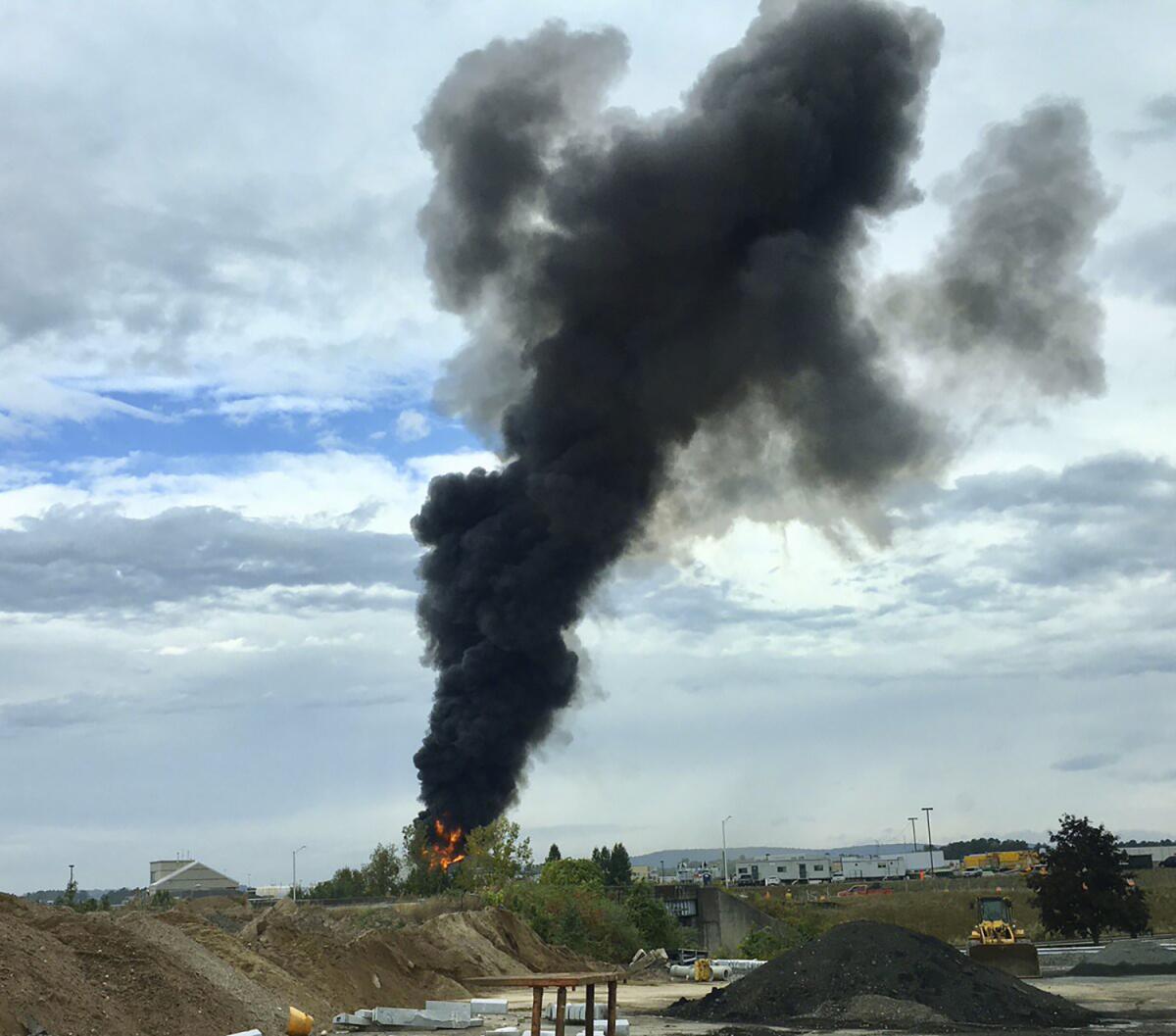World War II-era bomber crashes; at least 7 reported dead

- Share via
WINDSOR LOCKS, Conn. — A World War II-era B-17 bomber carrying 13 people crashed and burned at the Hartford airport in an aborted takeoff attempt Wednesday, killing seven of them.
The four-engine, propeller-driven plane struggled to get into the air and slammed into a maintenance shed at Bradley International Airport as the pilots circled back for a landing, officials and witnesses said.
It had 10 passengers and three crew members, authorities said.
Connecticut Public Safety Commissioner James Rovella said hours after the crash that some of those on board suffered severe burns and that “the victims are very difficult to identify.”
Some of the survivors of the crash were critically injured, authorities said. One person on the ground was also hurt and a firefighter involved in the response suffered a minor injury. No children were on the plane.
The death toll of seven could rise, Rovella said. He said some lives were likely saved by the efforts of others, including one who raced to help the victims and people on the plane who helped others to escape the fire by opening a hatch, Rovella said.
“You’re going to hear about some heroic efforts from some of the individuals that were in and around that plane,” he said.
The retired, civilian-registered plane was associated with the Collings Foundation, an educational group that brought its Wings of Freedom vintage aircraft display to the airport this week, officials said.
“Right now my heart really goes out to the families who are waiting,” Gov. Ned Lamont said. “And we are going to give them the best information we can as soon as we can in an honest way.”
The National Transportation Safety Board sent a team of 10 to investigate the cause of the crash.
The plane was a few minutes into the flight when pilots reported a problem and said it was not gaining altitude, officials said. It lost control upon touching down and struck the shed.
The airport — New England’s second-busiest — was closed after the crash but reopened a single runway about 3 ½ hours later.
Flight records from FlightAware shows the plane went down about five minutes after it took off. The data shows it had traveled about 8 miles and reached an altitude of 800 feet.
In recordings of audio transmissions, the pilot told an air traffic controller that he needed to return to the airport and land immediately. Asked why, he said: “No. 4 engine, we’d like to return and blow it out.”
Brian Hamer of Norton, Mass., said he was less than a mile away when he saw a B-17, “which you don’t normally see,” fly directly overhead, apparently trying to gain altitude but not succeeding.
One of the engines began to sputter, and smoke came out the back, Hamer said. The plane made a wide turn and headed back toward the airport, he said.
“Then we heard all the rumbling and the thunder, and all the smoke comes up and we kind of figured it wasn’t good,” Hamer said.
Antonio Arreguin, who had parked at a construction site near the airport, said he did not see the plane but heard the explosion and could feel the heat from “this big ball of orange fire” about 250 yards away.
The same plane also crashed in 1987 at an air show near Pittsburgh, injuring several people, the Collings Foundation said. Hit by a severe crosswind as it touched down, the bomber overshot a runway and plunged down a hill. It was later repaired.
The crash reduces to nine the number of B-17s actively flying, said Rob Bardua, spokesman for the National Museum of the U.S. Air Force near Dayton, Ohio.
Boeing-built B-17 Flying Fortresses — 74 feet long with a wingspan of 104 feet — were used in daylight bombing raids against Germany during the war. The missions were extremely risky, with high casualty rates, but were critical in breaking the Nazis’ industrial war machine.
Only a few of the roaring Boeing B-17s are still airworthy.
The B-17 that went down Wednesday was built in 1945, too late for combat in World War II, according to the foundation.
It served in a rescue squadron and a military air transport service before being subjected to the effects of three nuclear explosions during testing, the foundation said. It was later sold as scrap and eventually restored. The foundation bought it in 1986.
“This is kind of shocking. It’s a loss to lose a B-17,” said Hamer, whose father served in the Air Force. “I mean, there aren’t very many of those left.”
More to Read
Sign up for Essential California
The most important California stories and recommendations in your inbox every morning.
You may occasionally receive promotional content from the Los Angeles Times.










